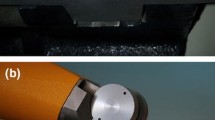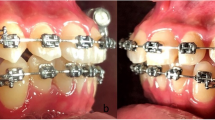Abstract
The objective of this paper is to evaluate magnetic field interactions at 1.5 and 3 T for 20 orthodontic devices used for fixed orthodontic therapy. Twenty springs and auxiliary parts made from varying ferromagnetic alloys were tested for magnetic field interactions in the static magnetic field at 1.5 and 3 T. Magnetic translational force Fz (in millinewtons) was evaluated by determining the deflection angle β [American Society for Testing and Materials (ASTM standard test method)]. Magnetic-field-induced rotational force Frot was qualitatively determined using a five-point scale. β was found to be >45° in 13(15) devices at 1.5(3) T and translational force Fz exceeded gravitational force Fg on the particular object [Fz 10.17–261.4 mN (10.72–566.4 mN) at 1.5(3) T]. Fz was found to be up to 24.1(47.5)-fold higher than Fg at 1.5(3) T. Corresponding to this, Frot on the objects was shown to be high at both field strengths (≥ +3). Three objects (at 1.5 T) and one object (at 3 T) showed deflection angles <45°, but Frot was found to be ≥ +3 at both field strengths. For the remaining objects, β was below 45° and torque measurements ranged from 0 to +2. Of 20 objects investigated for magnetic field interactions at 1.5(3) T, 13(15) were unsafe in magnetic resonance (MR), based on the ASTM criteria of Fz. The implications of these results for orthodontic patients undergoing MRI are discussed.




Similar content being viewed by others
References
Okano Y, Yamashiro M, Kaneda T, Kasai K (2003) Magnetic resonance imaging diagnosis of the temporomandibular joint in patients with orthodontic appliances. Oral Surg Oral Med Oral Pathol Oral Radiol Endod 95:255–263
Kemper J, Klocke A, Kahl-Nieke B, Adam G (2005) Orthodontic brackets in high field MR imaging: experimental evaluation of magnetic field interactions at 3.0 Tesla. Fortschr Rontgenstr 177:1691–1698
Klocke A, Kemper J, Schulze D, Adam G, Kahl-Nieke B (2005) Magnetic field interactions of orthodontic wires during magnetic resonance imaging (MRI) at 1.5 Tesla. J Orofac Orthop 66:279–287
Shellock FG (2005) Reference manual for magnetic resonance safety, implants, and devices. In: 2005 edn, Biomedical Research Publishing Group, Los Angeles, pp 122–134
Shellock FG, Tkach JA, Ruggieri PM, Masaryk TJ (2003) Cardiac pacemakers, ICDs, and loop recorder: evaluation of translational attraction using conventional (“long-bore”) and “short-bore” 1.5- and 3.0-Tesla MR systems. J Cardiovasc Magn Reson 5:387–397
ASTM (2002) Designation: F2052-02. Standard test method for measurement of magnetically induced displacement force on medical devices in the magnetic resonance environment. In: Annual book of ASTM standards, West Conshohocken, pp 1576–1580
New PF, Rosen BR, Brady TJ et al (1983) Potential hazards and artifacts of ferromagnetic and nonferromagnetic surgical and dental materials and devices in nuclear magnetic resonance imaging. Radiology 147:139–148
Shellock FG, Shellock VJ (1999) Metallic stents: evaluation of MR imaging safety. AJR Am J Roentgenol 173:543–547
Greatbatch W, Miller V, Shellock FG (2002) Magnetic resonance safety testing of a newly-developed fiber-optic cardiac pacing lead. J Magn Reson Imaging 16:97–103
Edwards MB, Taylor KM, Shellock FG (2000) Prosthetic heart valves: evaluation of magnetic field interactions, heating, and artifacts at 1.5 T. J Magn Reson Imaging 12:363–369
Kagetsu NJ, Litt AW (1991) Important considerations in measurement of attractive force on metallic implants in MR imagers. Radiology 179:505–508
ASTM (2002) Designation: F2213-04. Standard test method for measurement of magnetically induced torque on medical devices in the magnetic resonance environment. In: Annual book of ASTM standards, West Conshohocken, pp 1576–1580
Nogueira M, Shellock FG (1994) Otologic bioimplants: ex vivo assessment of ferromagnetism and artifacts at 1.5 T. AJR Am J Roentgenol 163:1472–1473
Shellock FG (1999) Metallic marking clips used after stereotactic breast biopsy: ex vivo testing of ferromagnetism, heating, and artifacts associated with MR imaging. AJR Am J Roentgenol 172:1417–1419
Planert J, Modler H, Vosshenrich R (1996) Measurements of magnetism-related forces and torque moments affecting medical instruments, implants, and foreign objects during magnetic resonance imaging at all degrees of freedom. Med Phys 23:851–856
Sommer T, Maintz D, Schmiedel A et al (2004) High field MR imaging: magnetic field interactions of aneurysm clips, coronary artery stents and iliac artery stents with a 3.0 Tesla MR system. Fortschr Rontgenstr 176:731–738
Kangarlu A, Shellock FG (2000) Aneurysm clips: evaluation of magnetic field interactions with an 8.0 T MR system. J Magn Reson Imaging 12:107–111
Shellock FG (2002) Biomedical implants and devices: assessment of magnetic field interactions with a 3.0-Tesla MR system. J Magn Reson Imaging 16:721–732
Sadowsky PL, Bernreuter W, Lakshminarayanan AV, Kenney P (1988) Orthodontic appliances and magnetic resonance imaging of the brain and temporomandibular joint. Angle Orthod 58:9–20
Colletti PM (2004) Size “H” oxygen cylinder: accidental MR projectile at 1.5 Tesla. J Magn Reson Imaging 19:141–143
Chaljub G, Kramer LA, Johnson RF 3rd, Johnson RF Jr, Singh H, Crow WN (2001) Projectile cylinder accidents resulting from the presence of ferromagnetic nitrous oxide or oxygen tanks in the MR suite. AJR Am J Roentgenol 177:27–30
Baker KB, Nyenhuis JA, Hrdlicka G, Rezai AR, Tkach JA, Shellock FG (2005) Neurostimulation systems: assessment of magnetic field interactions associated with 1.5- and 3-Tesla MR systems. J Magn Reson Imaging 21:72–77
Wittenauer MA, Nyenhuis JA, Schindler AI (2003) Growth and characterization of high purity single crystals of barium ferrite. J Cryst Growth 130:533–542
Author information
Authors and Affiliations
Corresponding author
Rights and permissions
About this article
Cite this article
Kemper, J., Priest, A.N., Schulze, D. et al. Orthodontic springs and auxiliary appliances: assessment of magnetic field interactions associated with 1.5 T and 3 T magnetic resonance systems. Eur Radiol 17, 533–540 (2007). https://doi.org/10.1007/s00330-006-0335-x
Received:
Revised:
Accepted:
Published:
Issue Date:
DOI: https://doi.org/10.1007/s00330-006-0335-x




